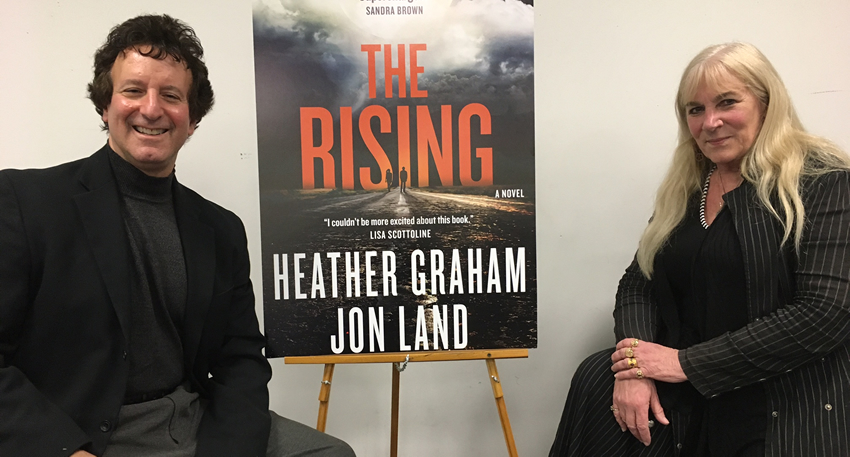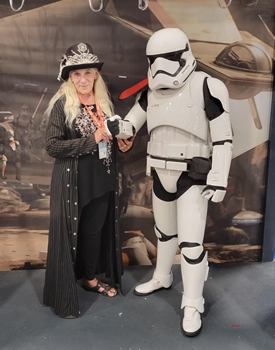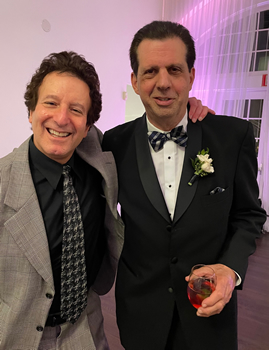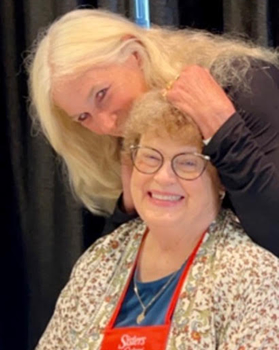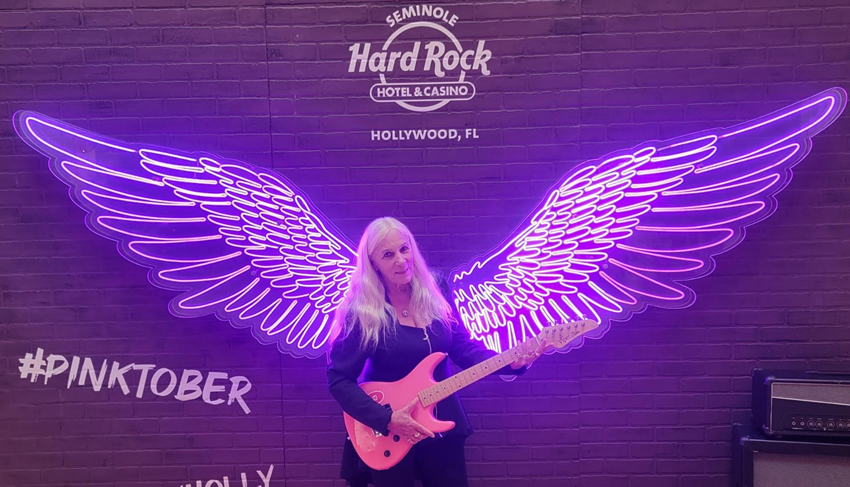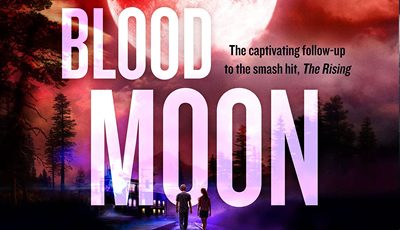

Features Up Close: Heather Graham and Jon Land
Beware the Golem
 By K.L. Romo
By K.L. Romo
High school senior Sam Dixon might just be her class’s valedictorian. Her classmate Alex Chin needs her tutoring, but he’s the star of the school football team. Although people expected these things from the teens, they would never have imagined Sam and Alex saving the world from well-camouflaged alien invaders.
In BLOOD MOON, Book 2 of the Rising series, bestselling co-authors Heather Graham and Jon Land use high-tech science for alien beings to infiltrate humanity.
In Book 1, The Rising, Sam and Alex thought they’d stopped the alien invasion intent on destroying Earth’s civilization. But that was just a warm-up. They will fight the next battle under a blood moon.
Sam is an intern at NASA’s Ames Research Center for astrobiology. Prior to a few days ago, the brainiac Sam was Alex’s tutor. But they’d paired up and somehow won the fight against the otherworldly enemy invaders under Alcatraz Island. Now Sam knows Alex is not just a high school senior, but a grown child of the leader of the resistance movement on another planet. With a computer chip implanted in his head, he’s the only one who can save the Earth from destruction.
The evil overlords from Earth’s parallel planet have dispatched otherworldly beings to Earth to kill refugees from their planet’s resistance movement. Just like Raiff—a soldier who brought Alex to Earth as an infant and has protected him since—came to Earth through a wormhole in space, so too have the deadly creatures ventured through the spacebridge. And what about the sorcerer whose elixir can create monsters out of mud—the infamous Golem? Can Alex and Sam save humanity from extinction?
Graham and Land use the backdrop of Earth as the home of alien refugees whose mission has always been to save their home planet. Wormholes, spacebridges, and ripples in the space-time continuum all challenge readers to consider what it will take to save humanity and Earth from destruction.
Here, Graham and Land talk with The Big Thrill about their inspiration for BLOOD MOON and the Rising series, their use of just enough science to make the story believable, and their process for being co-authors.
What was the inspiration for the story in this series and BLOOD MOON in particular?
JON LAND: Let’s start with BLOOD MOON. Heather and I learned about the Voynich Manuscript, an ancient book written in a language nobody’s ever been able to translate, which suggests that the language might be an alien one. Since our series features a hero who’s from another world, that seemed like the perfect jumping-off point for a classic quest story where our two teen heroes, Alex Chin and Samantha Dixon, follow the clues in a book only Alex can decipher to find four keys that are the only thing that can save the world from extinction.
As for the series itself, we conceived it when xenophobia was running rampant in the country after Trump’s infamous elevator ride. So we made our hero the ultimate illegal alien because he’s from another world. And let’s reverse the paradigm by having his parents be Chinese immigrants who have safeguarded Alex’s identity for his entire life. That didn’t feel like something anyone had ever done before, kind of a new take on the Robert Heinlein classic Stranger in a Strange Land.
HEATHER GRAHAM: There were so many things that just fell into place! I’d been on a few trips to the Goddard Space Flight Center, there was so much going on in the world, and … Jon and I had lunch. Our characters fell right into place, and we were off!
Did current world events play into the creation of the plot?
HG: Jon and I started the idea long ago over lunch. Bob Gleason (our editor at Tor) had taken a group of us to the Goddard Space Flight Center, something that proved to be amazing. Of course, we discussed the concept of aliens, and when a panel of scientists was asked if they would assume aliens were friendly or call out the military, there were different answers. My favorite was the young man who said that he didn’t know—answering such a question was above his pay grade, and he’d have to call his supervisor.
Just about the same time, I’d started a series of four books based on the Four Horsemen of the Apocalypse. Before the pandemic.
Do world events play into it? In a way, of course, maybe even at a sub-level. In the last years, we’ve seen a pandemic and wars play out. And I think we all want to believe that the human race will survive for our children and grandchildren and onward and want to have faith.
But I have faith, and I believe it shows in our characters. I just went over to the hurricane-devastated west coast of Florida to bring supplies to a Pride Center, and it amazed and delighted me to see that an unbelievable group of people of every color, gay and straight, and just about any ethnicity known to man, worked together beautifully helping others. We can have strength and courage against all odds, and I like those characteristics—while still noting human frailty—in our characters.
JL: I don’t have a lot to add; Heather kind of said it all. With the environment, humanity is its own worst enemy. We take nature for granted, and too many people are climate change deniers. So if we can’t unite to save our planet figuratively, how can we unite to save our planet literally? I fear that with a true extinction threat, the same divisions and denial would surface, and we’d come up short. I’m starting to believe that what we’re seeing in the world today isn’t a blip, so much as a total paradigm shift. We don’t agree on anything, so how can we agree on saving the world?
How did you go about researching wormholes, space-time continuums, spacebridges, and electromagnetic disturbances?
JL: Above all else, Heather and I are storytellers, and we’re blessed with only a layman’s knowledge of science. I say “blessed” because our intention was never to write a hardcore science fiction story on the order of Isaac Asimov or Frank Herbert. We weren’t interested in world building, so much as bringing the threat home, while stressing character over technology. In that regard, we didn’t want to be prisoners of technology or limited by it. So for our use of the elements you listed above, our approach brings to mind the great Robert Louis Stevenson quote that, “It doesn’t matter to me if you believe what I’m writing is real. It only matters that you do not disbelieve it.”
That spawned the notion of the suspension of disbelief, and we set out in this series to give you just enough information to understand the space-age jargon we use. We had a blast with that, especially the “Energy Creature” in BLOOD MOON, inspired by an episode from the classic sci-fi TV series The Outer Limits called “It Crawled Out from the Woodwork” and the monster from the equally classic film Forbidden Planet.
HG: Well, from the scientists at Goddard, I realized that I’d be way too old to enjoy a vacation to Mars by the time I got there—unless wormholes do exist. The concept of shifting time and space is always fascinating and helps create the ultimate “what if?”
Since your protagonists are seniors in high school, do you believe that young people will be the ones to save the Earth?
HG: Yes—and no! Three of my five young people now have young people, and I get to see a lot of young people. It’s up to us to create new generations of those who are strong enough to be kind, smart enough to know to hold fast to one’s beliefs, and also strong enough to listen to others and learn from them, to seek knowledge and compromise before violence.
JL: I have the benefit of mentoring and working with Brown University undergrads and being around them—and young people in general—is just about the most positive experience you can have. Their attitudes and optimism are so refreshing, and they are far more tolerant of others who don’t fit into the same box than our generation was.
It’s our generation, along with the one or two that came immediately after, that’s responsible for making a mess of the world and this country. While I’m not sure I’d go as far as saying that young people will be the ones to save the Earth, they might save the rest of us from ourselves, and that’s a start at least.
Is there a message you’d like readers to take away from the book?
JL: Studio head Samuel Goldwyn once famously said, “If you want to send a message, use Western Union.” So in my mind, the primary takeaway from BLOOD MOON is to make the adults who read it feel like kids again. That’s the way I feel when I read a Stephen King book or watch a series like Game of Thrones. I still remember watching the original Jason and the Argonauts as a little kid, sitting on the edge of my seat when the Colossus or Rhodes statue stepped down off its pedestal. Sure, the stop-motion animation special effects were chintzy by today’s standards, but it was magical to me. We’d love BLOOD MOON to bring that same magic to not-so-little kids.
HG: First, I want people to enjoy the story. When I was a kid, my parents bought me the Reader’s Digest Treasury for Young Readers. I loved it! Made me curious to keep finding out more and more about things that I’d discovered in the book. As I grew up and read more fiction, the books I read made me want to see other places and know more about history. Now to the best of my knowledge, we can’t meet any extra-terrestrials, but all the concepts and possibilities out there are fascinating and hey, maybe we’ll reach a future astronaut!
What is your method for writing as a team?
HG: The best is when we can meet—but he’s in Rhode Island and I’m in Florida, so it’s great that we were friends first and we get excited, even on the phone, when talking about plot twists, history that leads into what we want, and character evolution. Somehow, we’re a perfect fit together. Back and forth—and both always allowing input or accepting changes when one sees something as a better move, or even a better line.
JL: We handle the Big Stuff together: laying the book out, coming up with the plot twists, asking ourselves what makes the reader care about our characters, figuring out the structure. And if we get all that right, writing the book is easy. The key with a collaboration like this is to be on the same page (no pun intended!) about what’s driving the action and the characters.
And, with a series, how do we keep each book fresh and not repeat ourselves? We’re both very prolific, especially Heather, so that’s a challenge we’re each very suited to meet. The best thing about our collaboration is that working together helps incorporate the greatest strengths we each bring to the table.
Will there be a third book?
JL: Yes, and we’d be glad to tell you about it … if we knew ourselves yet. We’ve just started plotting out the third book in the trilogy that began with The Rising, and our priority is to come up with something new and fresh, not just a twist on the same thing. BLOOD MOON is an entirely different book than The Rising, and the third book will be fresh and different from the first two to make sure the series is fresh and not repetitive. (Which is the one complaint I have about the Netflix series Stranger Things. For all its brilliance, in my mind, each season has a been-there, done-that feel to it.)
HG: Yes, the hint is that there will be a third book! And I can say our characters will continue to grow, as we all did, traveling that rough path through adolescence to adulthood, with circumstances forcing some people to grow up fast!
- The Big Thrill Recommends: ONE BIG HAPPY FAMILY by Jamie Day - September 16, 2024
- The Big Thrill Recommends: ONLY ONE SURVIVES (Video) by Hannah Mary McKinnon - July 30, 2024
- The Big Thrill Recommends: WHAT YOU LEAVE BEHIND by Wanda M. Morris - June 27, 2024

